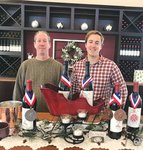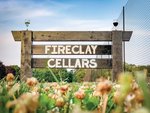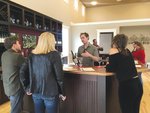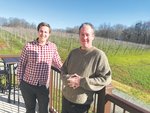




Erik Mitran, a native of Phoenix, grew up in the Raleigh area. Both his father (Andrei, who’s also an owner of FireClay) and grandfather had an interest in farming. Andrei and Erik’s mother, Sue, grew grapes when Erik was a child (and kept bees as well), which led to Erik’s interest in making wine and mead. That hobby became a business after Erik’s graduation from N.C. State (he earned a degree in chemical engineering), which led to the creation of FireClay Cellars. Mitran, his parents and another couple, Steve and Bonnie Thiedke, are owners of the business; each plays an active role, especially during harvest season.
Beau Hall’s earlier career saw him working in the gourmet and organic food markets of the Triangle before moving to the Yadkin Valley area of North Carolina in 2010 to pursue an education in Viticulture (the cultivation and harvesting of grapes) and Enology (the study of wine), all with the notion of helping to help raise the bar for N.C. wines and open the markets up for the smaller producers. After his 2012 graduation, Hall worked for several vineyards and wineries across the Yadkin Valley, moving to Chatham County in 2014 from Windsor Run Cellars/Shadow Springs Vineyards to work to establish the vineyard (which Erik and Andrei started planting in 2012) to get it cranked up in preparation for building and opening the winery/tasting room
What’s up at FireClay, and how’s it going after a year?
ERIK: It’s been fun and a very rewarding experience. We’ve hosted church events, fundraisers, potlucks and even a wedding. We’ve really enjoyed meeting our neighbors and other local businesses who have supported us and helped us build a community in Chatham County. We are excited to be a part of a community of wineries/vineyards in North Carolina, that are working together to share knowledge to further improve the wine in our State. Currently you will find us planting another acre of vines and beautifying the grounds for events coming up in this new year.
BEAU: It’s going great at FireClay. Technically the vineyard itself is actually eight years old with the winery/tasting room construction beginning in October of 2017. We’ve started doing fun stuff like music and food trucks, small wedding get-togethers and events, and some catered dinners as well. We have plans to plant 1,200 more new vines in the springtime so you can tell that this is a long-term project with new and exciting things happening all the time.
It all starts with grapes, but really, it starts with geography and soil: what’s growing at FireClay, and why have those specific grapes been chosen?
BEAU: Half of our new vines will be a red grape called Crimson Cabernet, which is vaguely similar to Cabernet Sauvignon but has better growing qualities for our conditions. The white grapes we grow are Chardonel, Traminette and Seyval Blanc. The other half of the new vines will be a white grape called Cabernet Dior. These are the varieties that we’ve found that we can grow well here and make a good wine. Figuring that out is an extremely critical part of the overall process.
ERIK: We are growing a variety of grapes that thrive in the viticultural region — Haw River Valley — that we are located in. We started searching for land with the intent of growing grapes around 2010. Soil pH, nematodes, drainage, airflow, slope/aspect, and many more factors were considered. We landed on a perfect spot on one of the high points of Chatham County, located right outside the Triangle. We planted around 10 different varieties and now we have Traminette, Chardonel, Tannat, Cabernet Sauvignon, Cabernet Franc and Chambourcin. Our long, hot summers, great soil drainage, and generous airflow allows us to excel at these varieties.
We removed Syrah, Merlot and Chardonnay for various reasons. For example, the Chardonel was out-performing the Chardonnay in flavor, grape quality, and grape chemistry (pH, acids, flavor). Chardonel is a hybrid grape created to be highly resistant to harsh weather and disease while retaining the flavor of Chardonnay. We couple Charodnel with a specific rootstock tailored to further control to flavor and grape chemistry in the vineyard.
We prefer the idea of “making the wine” in the vineyard. This allows us to take on a natural approach to the entire process of making wine. At harvest time, the grapes come directly into the winery which allows the fruit to be in its best condition, which in turn, makes the wine making production much easier.
How are things different there compared to other vineyards in North Carolina?
ERIK: We are located farther east than most vineyards growing these types of grapes. Our location gives us a hotter and drier summer. We end up watering the grapes very often throughout the summer. Our soil is also uniquely rich in minerals, giving us the bright red clay that we named our winery after...FireClay Cellars! We made an interesting discovery here, a fossilized clam shell, leading us to believe the land is rich in organic matter from the ocean floor.
The downside to being farther east is the susceptibility of Pierce’s disease that affects the crop (it is a bacterium spread mainly by an insect called a sharpshooter. This insect is limited by colder winter temperatures). This disease can infect and slowly kill certain grape varieties. We combat this in many ways, including growing resistant varieties and attending to vine health. You will notice our vines covered in a white clay at certain times of the year, which naturally prevents many insects from feeding on the vines.
BEAU: Being so far east compared to many other N.C. vineyards, we face several special challenges in growing the grapes that we do. Lots of red clay. No surprise there…this is North Carolina, after all. The vines actually like it pretty good, though; it’s really more the environmental and climatalogical factors that affect us. We get lots of mild winters and late frosts in the spring which can be quite tricky to navigate safely...and can be potentially devastating to your crop. We are extremely passionate about growing the best fruit we can, however, and I know that Erik’s going to make something great with whatever we generate.
Wine is more than just fermented grapes. Can you help unravel the mystery of how the grapes grown there end up bottled, then poured, then savored?
ERIK: We hand-pick all our grapes as early as possible in the morning, which helps preserve aroma and flavor…and it’s just plain cooler to work outside. We sort the grapes while we pick and sometimes right before they go into a machine called a destemmer. The destemmer essentially takes all the grapes off the stems in a gentle fashion. We can also choose to crush the grapes depending on variety and style of wine we are trying to produce. The reds get fermented on the skins (pressed when done fermenting) while the whites get pressed in our bladder press. We can control the pressure and how our press operates, which allows us further control over the style of wine. We even use dry-ice to help prevent oxidation and cool the grapes even more.
What do you make, and how is it unique?
ERIK: We are experimenting and creating new ideas all the time. I am very excited about our barrel-aged Chardonel which allows creamier, softer, slightly oakier white wine. We also make an off-dry Cabernet Franc Rose (which won a Silver Medal in the N.C. State Fair competition) which sold out pretty quickly. We have made more to bottle this upcoming spring! This past fall, we made a rose out of the Chambourcin as well. It has such an amazing cherry nose to it. We may end up splitting it into different batches and doing some dry and some sweeter.
Having more varieties of wines available for customers to try in the tasting room is always a great thing. I think it’s fun comparing two styles made with the same grape variety. We provide both the 2017 and the 2018 White Blends for customers during a wine tasting. This allows them to experience the two vintages.
What are the biggest challenges you face as vintner/producer in Chatham County, and in the growing world or winemaking?
ERIK: Our most memorable experience of how North Carolina’s unpredictable weather can affect us here in Chatham County happened the night of a hurricane.
Last year, we were in the process of pressing our red blend that just finished fermenting, and while we were sealing up the wine for storage, the power went out. I was quickly reminded that there was indeed a hurricane. Even thunderstorms (including tornadoes) can be severe, and a wind gust toppled over a few rows in the vineyard, snapping the trellis poles. Spring frosts, insects, rain, and birds are just a few things to worry about. The vines are going into their ninth year and I’m sure I haven’t experienced all the challenges yet, but that’s OK. I used to stress about the weather, but now I plan ahead, adapt, and manage with patience.
What’s ahead?
ERIK: We have a few exciting hybrid varieties we are planting this spring, Crimson Cabernet and Cabernet Dore. I don’t think anyone in N.C. has planted these varietals yet so it will be a great test for other vineyards to check out as well.
Currently, we have on display local artists’ paintings, photography and sculptures as well as crafts and pottery. We continue to welcome our local musicians to perform for customers. An update for these events can be found on our social media and website (fireclaycellars.com).
We are also really excited to continue with the tradition of Mardi Gras by hosting the big event at our winery on Saturday, Feb. 22. We will have New Orleans-style foods, music (performed by the David Quick band) and decorations to celebrate the evening.